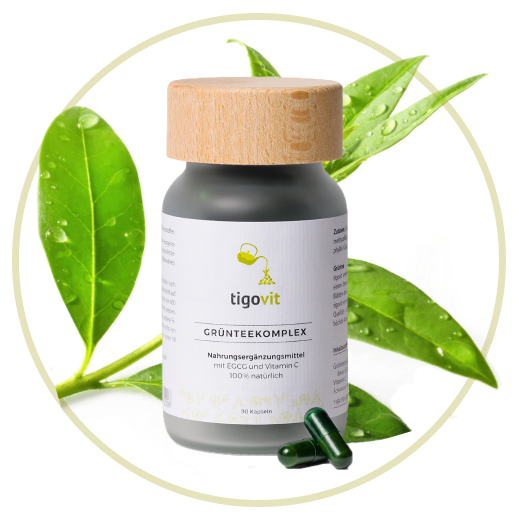Green tea has experienced a boom as a drink in recent years. And also as an active ingredient in skin care, the "gold of Asia" creates a sensation and that certain glow on the skin.
Another exciting ingredient for beautiful skin that is on the rise right now: probiotic bacterial strains! Who would have thought it, but probiotics in creams are currently conquering the cosmetics market and showing that probiotics don't just belong on your plate.
What effects the probiotic bacteria and also green tea have for the skin, and whether even the combination of these two substances is the key to a better skin isyou can find out here.
GREEN TEA AS A BEAUTY BOOSTER
Green tea is called "liquid jade" in some cultures. Extracted from the Camellia sinensis plant, it has been used for centuries for beauty. One of the most powerful antioxidants are polyphenols, which are found in green tea. The most important one here is a catechin called epigallocatechin gallate, also known as EGCG.
Studies show that the Antioxidants in green tea have a protective effect against cell damage and free radicals. One of the most interesting studies(2) looked at forty women with moderate skin ageing. One group received a green tea nutritional supplement with green tea cream. The other group received placebo products. Biopsies of the skin were taken at the end of the study. Women who were given the Green tea products given had significantly increased elasticity, while the placebo group showed no improvement.
GREEN TEA AGAINST ACNE
Goodbye pimples: According to a study(1), the consumption of green tea could help reduce acne. The antioxidant contained in green tea is said to be responsible for this. EGCG (epigallocatechin gallate), which is known for its anti-inflammatory effect.
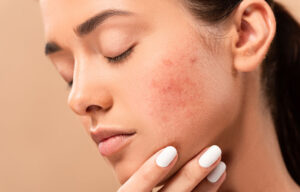
At the end of the four weeks, it was shown that the women who had consumed the green tea had significantly less acne in the critical areas such as the nose and chin. The antioxidant EGCG (epigallocatechin gallate) contained in green tea is said to be responsible for this. Interestingly, the group of women who consumed the Green tea extract also had much lower cholesterol levels.
The ingredients contained in green tea could therefore improve inflammation, reduce irritation and redness and help the skin to repair itself.
ANTI-AGING WITH GREEN TEA
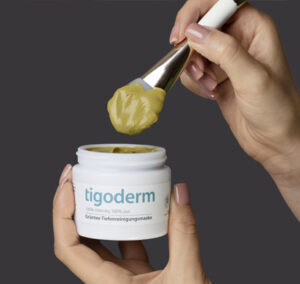
Good news for green tea fans: Anti-inflammatory, antioxidant and repair properties of EGCG protect the skin from premature ageing and wrinkling. In studies(3), a preventive effect and a smoothing of the skin thanks to green tea could be observed above all. In many cases, already existing wrinkles disappeared. The Skin texture worked overall smoother, firmer and altogether younger due to the active ingredients contained in green tea.
MICROBIOME: THE ECOSYSTEM OF YOUR SKIN
The largest organ in our body forms one of the most important microbial environments: the skin. Weighing over 5 kg, it is an interface between the inside of our body and the outer shell. It performs an important protective function, the barrier function, and is home to many microbial organisms responsible for the health and beauty of the skin.
This unique position makes the skin very vulnerable. The stress of daily life can weaken the microorganisms(4) that populate the skin. The lack of protection makes our skin more helpless against environmental influences such as smog, UV radiation and stress.
Just like the intestine, the skin is also a habitat for numerous living microorganisms, i.e. bacteria. This bacterial carpet, also known as microflora, maintains the skin's natural acid mantle and strengthens the cells against free radicals, pathogens and bad bacteria that can cause inflammation.
WHAT IS PROBIOTIC SKIN CARE?
Probiotic cosmetics is the new "must-have" that is just being discovered by research for skin care. In this process, beneficial extracts of "good" bacteria that have a positive influence on the skin are added to creams and lotions. The aim is for the bacteria to settle in the areas to which they are applied and have a targeted effect there.
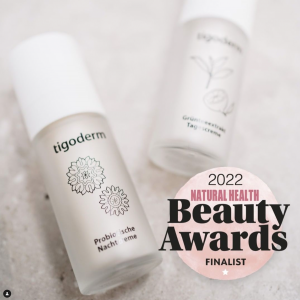
As soon as they touch the skin, the bacteria are activated. The good ones multiply while the weakening ones are diminished. The body's own protective debt to the skin is stabilised and strengthened, and it's all thanks to the probiotic bacteria.
But what does probiotic actually mean?
The label "probiotic" may already be familiar from yoghurts or drinks with live lactic acid bacteria. They are very useful for our intestinal flora. Probiotic skin care, like food, uses the Positive effect of probiotics. The living microorganisms such as lactic acid or special bacteria are added to creams and lotions. They are designed to naturally strengthen the skin's protective layer and support skin functions.
WHAT ARE PREBIOTICS, PROBIOTICS AND POSTBIOTICS?
In skin care, mainly pre- and probiotics are used for this purpose:
– Probiotics are living organisms or those that can activate themselves - lactic acid bacteria, for example.
– Prebiotics are nutrients for probiotics (mostly not organisms), such as fibre in the gut.
– Postbiotitka are products produced by probiotics such as insulin, fatty acids, messenger substances, hormones, enzymes.
PROBIOTIC COSMETICS: BRINGING THE SKIN INTO ITS NATURAL BALANCE
Probiotics can have a positive effect on the balance of the skin's own microbiome in different ways. It depends on which strains of microorganisms are involved in the individual case. Some dock onto skin cells and strengthen the protective barrier. Others serve as food for the skin's own microorganisms.
BETTER UPTAKE OF ACTIVE INGREDIENTS BY BACILLUS SUBTILIS
And what about the benefits of probiotic bacteria? Spore-forming bacteria such as the Bacillus subtilis have long been used for their high heat resistance as a Probiotics for the diet used. Its spores are extremely resistant to desiccation and tolerate a wide pH range, which are considered characteristics of good probiotic bacterial strains.
In addition, this bacterium has several properties that make it a perfect candidate for skin care. Numerous studies confirm that the application of bacterial cultures on the skin surface provides improved skin permeability, which is a crucial factor for successful skin treatment. The active ingredients can work where they should: in the skin.
EGCG & PROBIOTICS: THE PERFECT COMBINATION FOR THE SKIN
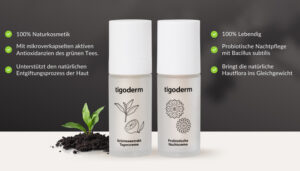
And this is where it gets exciting, because a care enriched with the pore-opening Bacillus subtilis, prepares the skin for the active ingredients that follow. These can then be absorbed all the better and unfold their beneficial effect. And this in deeper layers of the skin.
If the skin is then pampered with special ingredients such as green tea and its antioxidant power, the outer shell can be protected from environmental influences and free radicals and the skin's natural detoxification function can be supported. A fountain of youth at the cellular level that makes the skin elastic and gives it resilience.
IS PROBIOTIC SKIN CARE VEGAN?
Depending on what is used as a source of bacteria: The commonly used lactobacilli, which are made from milk, are of course not vegan. But you can also get lactobacilli from sauerkraut and then they are vegan. Bacillus subtilis is also a vegan bacterium, because it occurs in nature in humus-rich soil (hay), dust, air, water, in the intestines of humans and animals.
WHO IS PROBIOTIC SKIN CARE SUITABLE FOR?
In principle, probiotic skin care is suitable for everyone, regardless of their age. Skin type is available. Any skin that could use more vitality and resilience could try the new, scientifically studied active ingredients, probiotics in skin care.
Sources:
- https://ichgcp.net/de/clinical-trials-registry/NCT01687556
- https://pubmed.ncbi.nlm.nih.gov/22526068/
- https://www.ncbi.nlm.nih.gov/pmc/articles/PMC6412948/
- https://europepmc.org/article/MED/32664353#B54-microorganisms-08-01023


